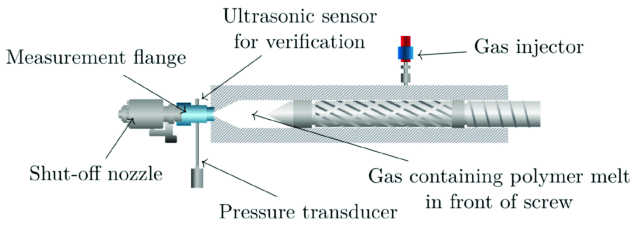
Plasticizing in injection molding is a crucial phase where solid plastic pellets are transformed into a homogeneous molten state, making them ready for injection into the mold. This process is essential for producing high-quality molded parts with consistent properties.
The Plasticizing Process
1. Material Feeding
The process begins with plastic pellets being fed from a hopper into the injection molding machine’s barrel. The hopper stores the raw plastic material, which can be various types of thermoplastics such as polyethylene (PE), polypropylene (PP), polystyrene (PS), or polycarbonate (PC).
2. Melting
Inside the barrel, a rotating screw pushes the pellets forward. As the pellets move, they are heated by a combination of external heaters and the shear heat generated by the screw’s rotation. This heat causes the pellets to melt gradually.
3. Homogenizing
The rotating screw not only conveys but also mixes the molten plastic to ensure a uniform temperature and consistency. This homogenization step is critical for preventing defects in the final product by ensuring that the material has consistent properties throughout.
4. Metering
Once the plastic is fully melted and homogenized, the screw retracts to accumulate a specific amount of molten plastic in front of it. This metered amount is precisely calculated to match the volume needed to fill the mold cavity.
[elementor-template id=”4330″]
Importance of Plasticizing in Injection Molding
Consistency and Quality
Plasticizing ensures that the molten plastic has a uniform temperature and composition, which is essential for producing high-quality parts with consistent mechanical properties and surface finishes.
Efficiency
Efficient plasticizing reduces cycle times by ensuring that the plastic melts quickly and uniformly, minimizing the time required for the injection and cooling phases.
Material Properties
Proper plasticizing preserves the inherent properties of the plastic material, such as tensile strength, impact resistance, and flexibility. Overheating or inadequate melting can degrade the material, leading to inferior parts.
Factors Affecting Plasticizing
Temperature Control
Accurate control of barrel and screw temperatures is crucial. Different plastics have specific melting points, and maintaining the correct temperature profile ensures optimal melting and prevents material degradation.
Screw Design
The design of the screw, including its length, diameter, and geometry (such as the pitch and flight depth), affects the efficiency of the plasticizing process. Screws are often tailored to specific materials to enhance melting and mixing performance.
Screw Speed and Back Pressure
The speed at which the screw rotates and the back pressure applied during plasticizing influence the shear heat generated and the mixing efficiency. These parameters must be optimized to balance melting speed and material quality.
Common Issues in Plasticizing
Material Degradation
Excessive temperatures or prolonged residence times in the barrel can degrade the plastic, causing discoloration, reduced mechanical properties, and surface defects in the molded parts.
Incomplete Melting
Insufficient temperatures or improper screw design can result in incomplete melting of the pellets, leading to unmelted particles in the mold and poor part quality.
Air Entrapment
Inadequate venting or improper screw operation can trap air in the molten plastic, leading to voids, bubbles, and weak spots in the final product.
[elementor-template id=”4331″]
Practical Example
Consider the production of a high-precision medical device component using polycarbonate (PC):
Material Selection
Polycarbonate is chosen for its excellent clarity, strength, and impact resistance.
Temperature Settings
The barrel temperature is set between 280-320°C (536-608°F), which is optimal for polycarbonate.
Screw Design
A general-purpose screw with a length-to-diameter ratio of 20:1 is used, featuring a gradual compression zone to ensure efficient melting and mixing.
Process Optimization
The screw speed and back pressure are carefully adjusted to achieve a consistent melt flow and prevent material degradation. Frequent monitoring ensures that the molten plastic remains at the desired temperature and viscosity.
Quality Control
Samples are taken periodically to check for uniformity, absence of bubbles or voids, and adherence to mechanical specifications. Adjustments are made as necessary to maintain the quality of the final parts.
Conclusion
Plasticizing is a fundamental process in injection molding that transforms solid plastic pellets into a homogeneous molten state, ready for precise injection into molds. By ensuring consistent melting and mixing, the plasticizing phase plays a crucial role in the quality, efficiency, and performance of the final molded parts. Proper control of temperature, screw design, and process parameters is essential to achieve optimal plasticizing and produce high-quality injection-molded products across various industries.
Related Conten: https://www.m-dtg.com/service/plastic-assembly-decoration/
 DTG Mould Trade Process |
|
| Quote: | According to sample, drawing and specific requirement. |
|---|---|
| Discussion | Mold material, cavity number, price, runner, payment, etc. |
| S/C Signature | Approval for all the items. |
| Advance | Pay 50% by T/T |
| Product Design Checking | We check the product design. If some position is not perfect, or can not be done on the mould, we will send customer the report. |
| Mold Processing | Send report to customer once each week |
| Mold Testing | Send trial samples and try-out report to customer for confirmation |
| Mold Modification | According to customer’s feedback. |
| Balance Settlement | 50% by T/T after the customer approved the trial sample and mould quality. |
| Delivery | Delivery by sea or air. The forwarder can be designated by your side. |
 |
|

